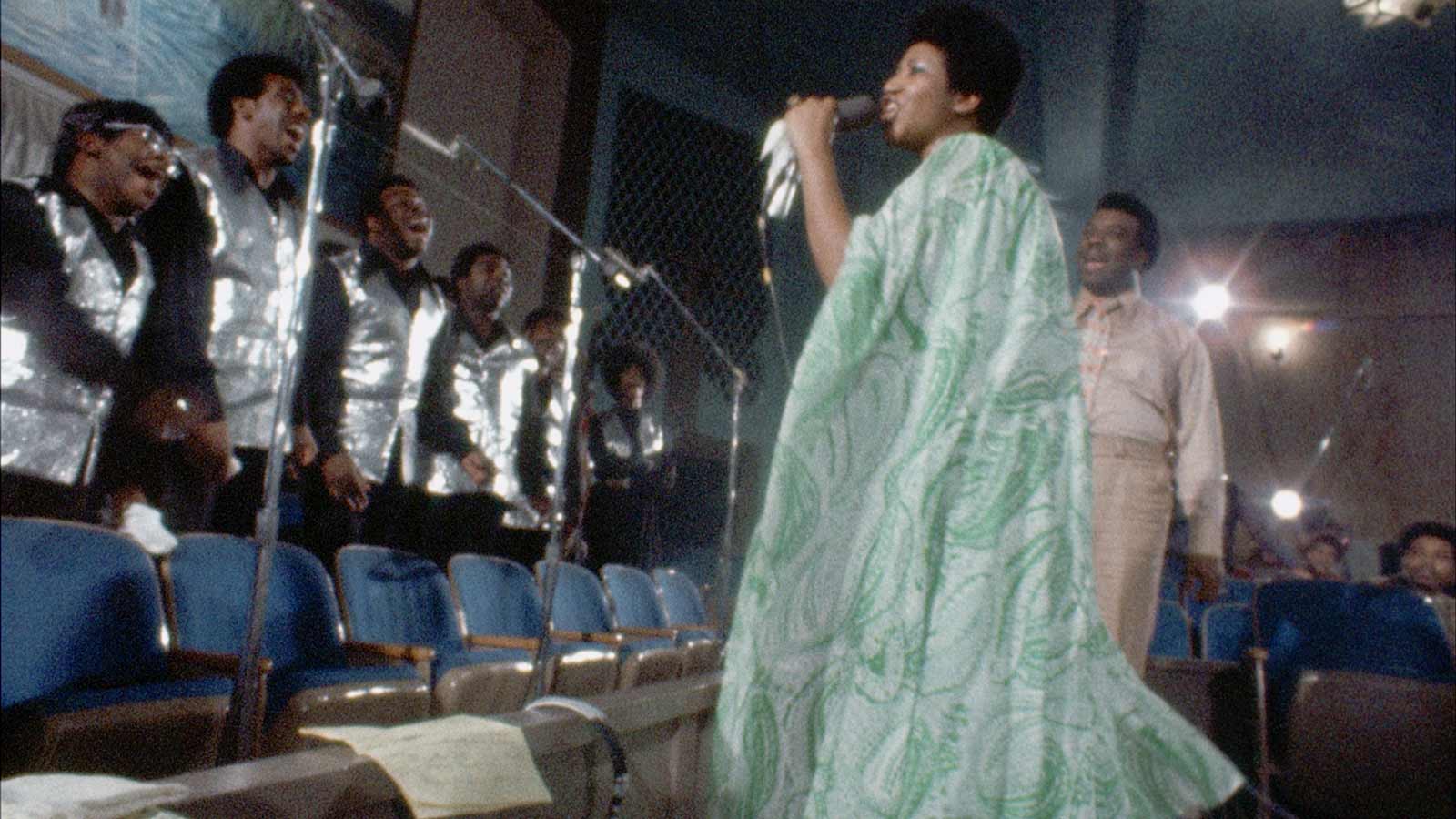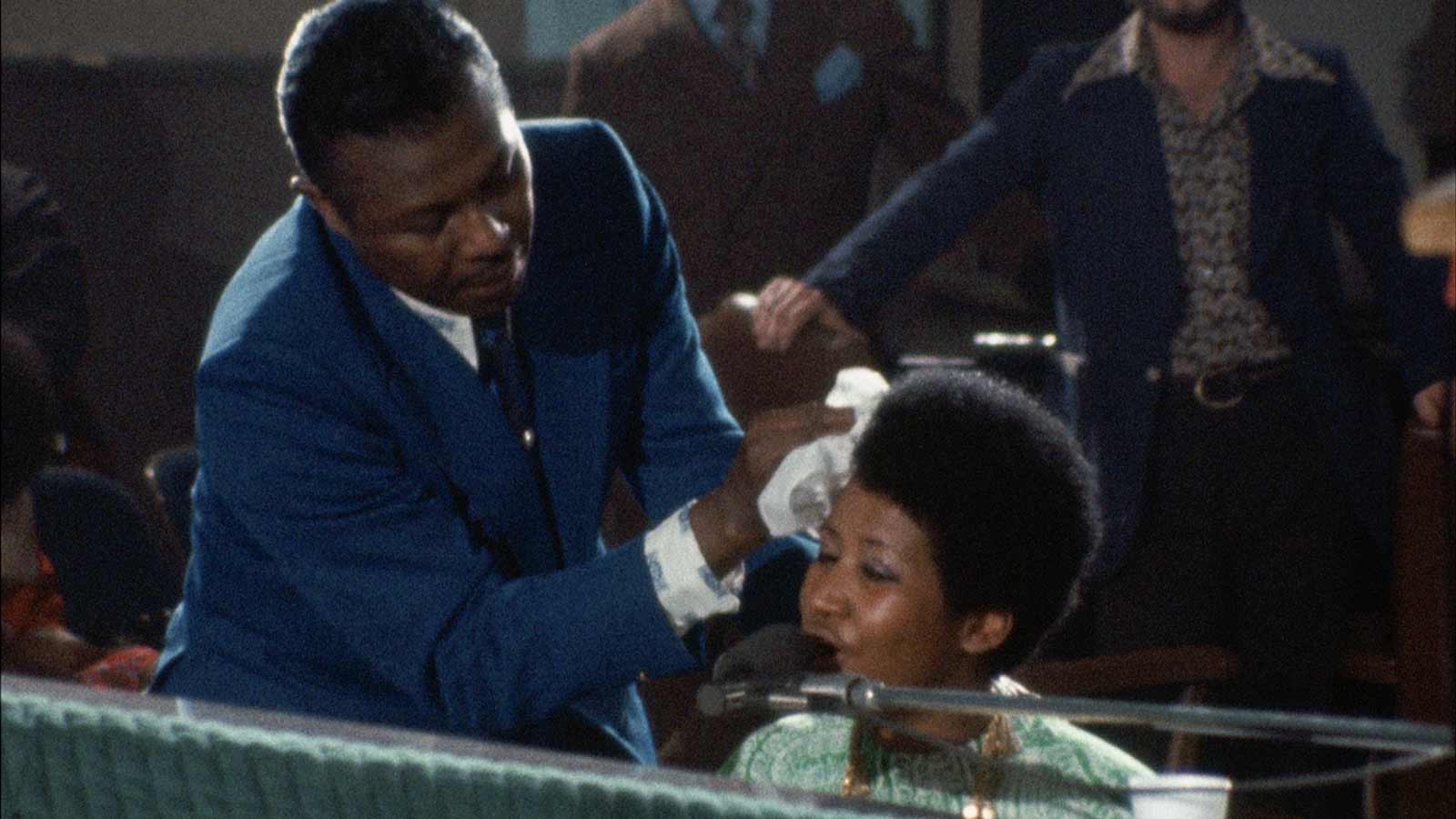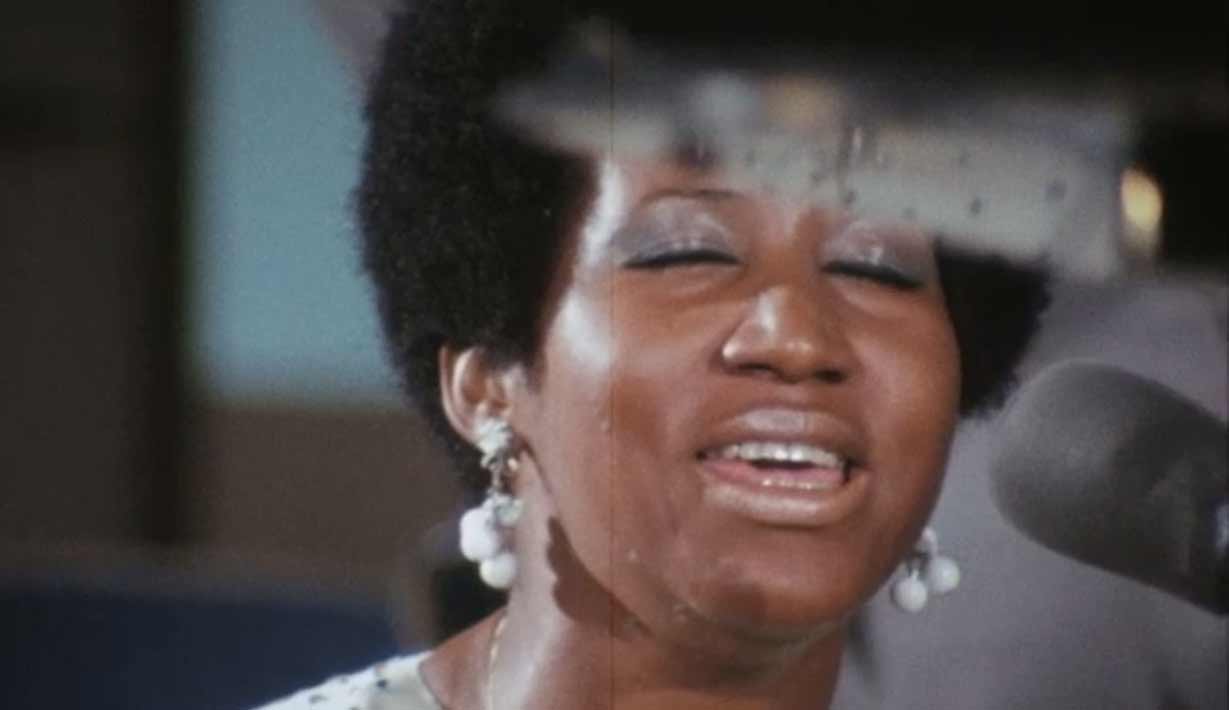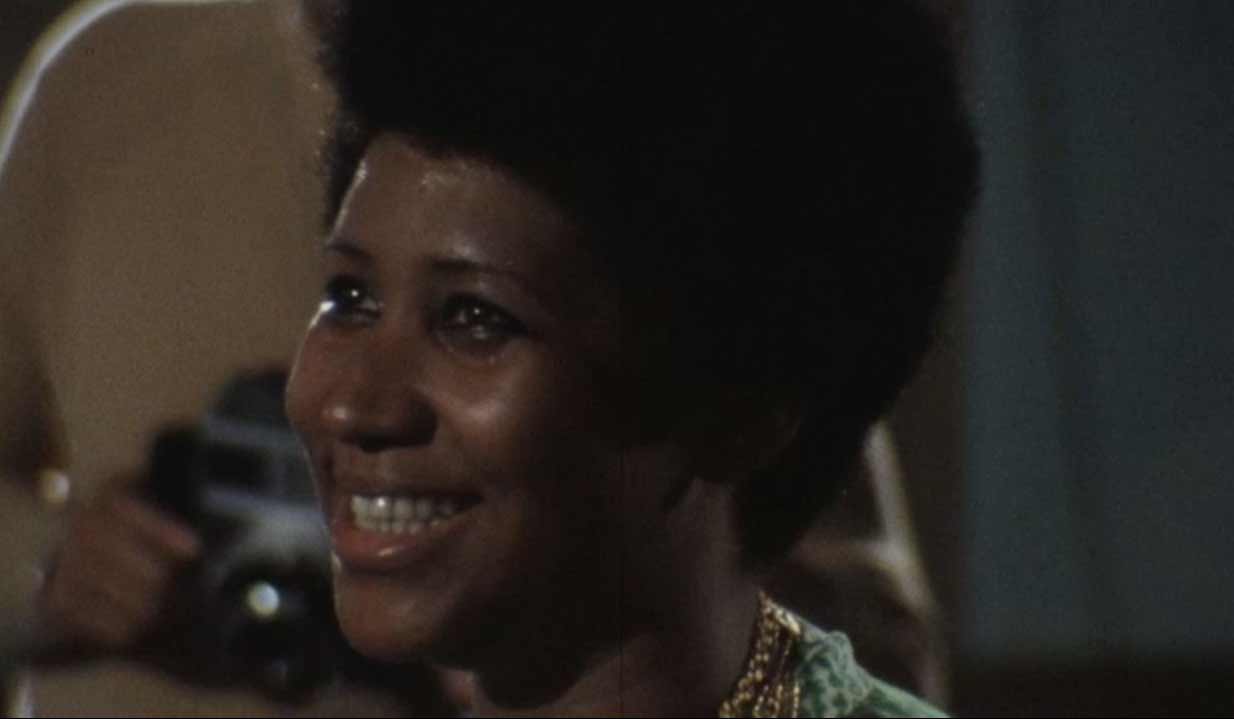The queen’s power dwells in her silence. That’s not what one expects to learn from a film about an almighty singer whose voice created a score for several dramatic decades of American life, and who will be ever defined by the way that voice made people feel. But it’s one of many striking revelations about Aretha Franklin in a new film that stars her, a film that is extraordinary in part because of the sense in which it’s not new at all.
Amazing Grace, Franklin’s double album released in 1972, saw the soul-pop superstar return to her “gospel roots”—on her own terms and with the aim less of returning to church than of tying its songs to her search for roots of a different kind; on the cover of the album she wears an Afrocentric gown. Made up of old spirituals and newer tunes lent Old Testament weight, the album went on to sell two million copies. The film of the same name documents its making. It captures Franklin—along with a crack band, a soaring choir, and a church full of exultant congregants in South LA—pouring her sweat and self into gospel classics such as “Precious Lord” and “The Old Landmark” and “Mary, Don’t You Weep” over two nights at the New Temple Missionary Baptist Church in Watts.
The footage it uses was shot by a young Sydney Pollack. But the finished film was no more completed by him than Aretha Franklin “didn’t want you to see it,” as you may have read after its triumphant unveiling in New York late last year. The singer did file a lawsuit, during the Telluride Film Festival of 2015, to delay its release. Four years ago, I was among those in the Colorado mountains clamoring to see a film that was already being spoken of, by those lucky enough to have previewed it, as a kind of missing lodestone in the visual archive of American music. When Amazing Grace finally reaches theaters this spring, it will have traveled a long and winding road to a screen near you. But the famously tricky star’s wrangling over a movie she’d once enthusiastically backed is but a footnote to the larger tale of how it finally came to be.
When Pollack was hired by Warner Brothers to film Aretha Franklin recording her album, he’d made They Shoot Horses, Don’t They? but had no experience documenting music. His failure to sync the images he shot with their corresponding sound caused the project to be shelved for decades (perhaps mercifully, given the studio’s misguided intention to release it in tandem with the 1972 blaxploitation movie Super Fly). It was around 2007 when Alan Elliott, a protégé of Franklin’s producer at Atlantic Records, Jerry Wexler, decided to rescue the footage from oblivion. With the help of new technology and after years of work, Elliott cut and assembled a new film that, by 2015, was ready for its debut.

It was a few hours before the film’s would-be premiere for a few hundred of us there, including a coterie of the movie’s lesser-known performers and makers who’d made the trip to Telluride, that word arrived from over the mountains: Franklin sought an injunction in federal court in Denver to forestall a film that—notwithstanding her old contract assenting to its making—she said represented a breach of “her rights to use and control her name and likeness.” When potential distributors offered the amount of money she wanted, she in fact agreed to the film’s release. But a series of deals fell apart for reasons including the fact, unknown by many of the lawyers and agents trying to get her on the phone, that she had pancreatic cancer. And then, last August, the Queen of Soul died, aged seventy-six.
Elliott flew to Detroit for her funeral. Over years of trying to win the star’s blessing to release the movie, he had befriended her family, and he and Sabrina Owens, a niece of Franklin’s who is now handling her estate, arranged for a screening of Amazing Grace for Franklin’s heirs and kin. They readily agreed that her memory and legacy could only benefit from this superlative portrait of the singer at her absolute peak, performing the songs that made her.
Amazing Grace is not a “documentary” in the sense we’ve come to understand the genre, at a time when most examples of it gather a familiar set of elements—archival footage and freshly shot interviews, photographs and ephemera—to assemble a narrative. Instead, it consists entirely of footage of what took place those two nights in Watts (along with a few segments filmed from the preceding days’ rehearsals), artfully edited into a rhythmic whole whose arc is less narrative than imagistic.
Advertisement
Unlike more overtly “ethnographic” films in the music documentary canon—for example, Les Blank’s gentle portraits of Cajun fiddlers and Texas bluesmen—there’s no illusion or intent of capturing folk culture in its unaffected context. The occasion we’re witnessing, in a sanctuary filled with recording gear and a crew of scruffy cameramen hopping among the musicians, involves showbiz artifice further manipulated by Elliott’s arrangement of the songs and footage for optimal effect. But part of the film’s power is the setting: a humble church, housed in an old neighborhood cinema, that’s filled with neighbors and friends and family of the performers. Their response to this music—their music—is authentic indeed. Authentic, too, is the tenderness glimpsed between Aretha and her father, the august preacher C.L. Franklin, when he joins the proceedings to wipe sweat from her brow under Pollack’s hot lights, and the emotion that grips the Reverend James Cleveland, the gospel maestro who taught Aretha piano and serves as the session leader. In the midst of his former pupil’s sublime rendition of “Amazing Grace,” Cleveland leans over his chair in sobs.

All the while, we remain aware that we’re watching professionals at work. Which is why it’s so fascinating to absorb that the leading professional there, the woman at the center of it all, scarcely utters a word. The afro-ed singer who had brought together a room filled not merely with some of the essential figures of black faith and politics in the twentieth century, but also those shaping pop culture at large in the early 1970s, is silent. Regal in bearing, yet with worry in her eyes, she responds to the gazes of all with no more than gentle nods. Through it all, she keeps her lips closed. Except, that is, when she sings.
*
In January 1972, Aretha Franklin was twenty-nine years old. She had started singing, as many know, in the Detroit church of her famous father. C. L. Franklin’s sermons from New Bethel Baptist—from whose pulpit a visiting Martin Luther King, Jr. first tried out his sermon about having a dream—were broadcast nationwide. Franklin signed to Columbia Records at eighteen, leaving behind Detroit and her family to launch a career that at first saw her promoted by storied producer John Hammond as a jazz singer. She recorded some underrated forays into the American songbook, but gained only middling success. After she moved to a new label and a new producer in 1965, signing with Jerry Wexler at Atlantic Records, she found the muscular sound that made her a star with hits like “Think” and “Chain of Fools,” and her belting cover of label-mate Otis Redding’s “Respect.” As the civil rights movement’s mid-Sixties apogee gave way to a wary period of riots and disillusionment culminating in Dr. King’s murder in 1968, Franklin wasn’t the only member of her cohort drawn to more radical kinds of searching.
Living in New York, she was drawn to the Black Arts movement of Nikki Giovanni and Larry Neal and immersed herself in a relationship with a new boyfriend, Ken Cunningham, who, during a vacation in Barbados, snapped the photo that would be used on Amazing Grace’s album cover. In 1971, she was getting ready to release a record built around her version of Nina Simone’s “To Be Young, Gifted and Black.” Whether it was Franklin or Wexler who first had the idea that the time was right to record a live album of church songs depends on which of them you asked, as the writer Aaron Cohen notes in his 2011 book on the album’s making. But producer and star agreed it was a good idea. They moved with alacrity to reconnect the two musical realms, the sacred and the profane, that had not, in fact, grown nearly so separate as some liked to pretend. The man widely known as the father of gospel, Thomas Dorsey, had switched back in the late 1920s from singing whorehouse hokum like “It’s Tight Like That” to mixing Christian praise-singing with the blues. The idiom he created reached perhaps the peak of its expression in Aretha’s Amazing Grace.
“If you want to know the truth, Aretha never left the church!” C.L. Franklin’s memorable exclamation on the album, we learn from the film, was uttered on the second night of recording. We watch him enter the church with his bouffant-coiffed and stole-wearing companion, the gospel legend Clara Ward, and it’s her song, “How I Got Over,” that they watch C. L.’s daughter perform. Rising from his seat in the front row, the Reverend Franklin is a debonair figure in a royal blue suit, his hair slicked straight, his cadence mesmeric as he extols her gift (“not only because Aretha is my daughter; Aretha’s a stone singer”) and emphasizes that she’d never left Jesus. True, too, was his insistence that he bore no hostility to black music of the non-God-fearing kind. “Some church people didn’t approve [of] the blues,” Franklin later told the scholar Jeff Todd Titon. “But they didn’t understand that it was part of their cultural heritage.”
Advertisement

Not for him was the sort of handwringing seen from some of his Christian brethren when another child gospel star from the Midwest, Sam Cooke, “went secular” in 1957. Cooke got his start as the teenaged lead of the Chicago gospel troupe The Soul Stirrers (which led him to visit Detroit often enough to stir a fierce crush in the Reverend Franklin’s daughter), before he went west to make his name. The satin-voiced crooner of “You Send Me” and “Cupid” died a sinner’s death on Figueroa Street in 1964, his bullet-riddled body sprawled near the red Ferrari he’d driven, with a mysterious consort, to the Hacienda Motel. That was only a few blocks from where Franklin, eight years later, would record Amazing Grace. Her first call, when she arrived, was to another Chicago transplant in LA, the Reverend James Cleveland.
Reverend Cleveland presides over the concert from his seat at the piano, a charming and chubby figure straining his polyester suit. Cleveland’s rise to gospel eminence began as a boy soprano in the very Chicago church of Thomas Dorsey, who changed his life—and, with it, American music—after his wife and son died in 1932. Disconsolate, Dorsey wrote the song “Precious Lord, Take My Hand,” which Cleveland and Franklin perform as a duet that glides into a medley with Carole King’s “You’ve Got a Friend.”
Their comfort with each other, palpable on screen, dated from Cleveland’s stint living with the Franklin family in Detroit when Aretha was a girl. (She later credited his big chords and striking harmonies—“his piano technique was pure gospel”—with doing more than anyone to help her find her voice.) In 1962, he had moved out to LA to produce records and festivals whose devotees both made “the modern gospel sound” and made it big business (his Gospel Workshop of America is still thriving). Another part of the empire over which Cleveland presided was the Southern California Community Choir, an all-star team of vocalists who wouldn’t even consider arrangements with harmonies in less than four or five parts.
Transcendent on record, they appear even more so on film. Marching down the aisle of New Temple Missionary, the choir’s twenty odd members—women and men, old and young—wear shiny silver vests and black bell-bottom pants. Seated in their old-style movie chairs or standing to shout praise or encouragement (“Go ’head, Aretha!”), they form an entourage, too, for a lanky and smiling figure who emerges as the film’s unsung star, introduced by Cleveland as “this wonderful young man, Alexander Hamilton.” He’s a vocal conductor as marvelous as his name. Glimpsed giving Aretha a soul handshake on the first night, he’s plainly won her respect. A few songs later, the film flashes back to a rehearsal and we see why: Hamilton confirms for her that yes, indeed, they would be doing “How I Got Over“ in the key of F. For that tune and all the others, back in church, he and Aretha stand back to back, a few feet apart. Arms swooping, head sometimes tilted skyward, Hamilton is grace itself as he directs the choir.
*
If the great choir he conducts spurs Aretha to touch parts of her range and self not reached when singing solo in an airless studio, Cleveland’s group had also never played with a rhythm section as accomplished as hers. Bassist Chuck Rainey, guitarist Cornell Dupree, and drummer Bernard “Pretty” Purdie were Franklin’s regular touring band by then. As top session men, they had also recorded hits by artists ranging from Quincy Jones to James Brown, Lena Horne, and B.B. King. That Pollack’s crew was unfamiliar with shooting concerts is nowhere more obvious than in how little they focused on these players. But in the glimpses we do catch, Rainey, Dupree, and Purdie are all well-kempt afros and knowing smiles. We sense them, used to the discipline of making two- or three-minute-long radio-friendly cuts, reveling in the chance to stretch out—and to return to the music of the black church.
Purdie, as perhaps his generation’s most in-demand drummer in rock, soul, and jazz alike, was known for a patented beat that propelled hits by Led Zeppelin and Steely Dan. Raised Methodist, Purdie often credited the sound of trains rumbling through his Maryland hometown when he was a boy with helping inspire his propulsive “Purdie shuffle.” In the ensemble’s swaying rendition of “God Will Take Care of You,” Cleveland calls the band to a simmer and asks, in his gravelly voice, who knows “how they do things in the Sanctified Church?” Franklin raises her hand, but Purdie, too, is also familiar with the ways of Pentecostal “saints.” He kicks into a triple-time shuffle, locking in with Rainey’s roiling bass.
The shots here of people dancing include an older black woman in a velvet dress who appears to faint. This woman, though she isn’t identified in the film as such, is Clara Ward’s mother. At one point, Cleveland throws a towel at Franklin in joy. The previous year, she’d performed with Dupree and Purdie for hippies at San Francisco’s Fillmore West. Here in Watts, there are only a few white people in the room besides the cameramen and sound crew, but two you can’t miss: Mick Jagger and Charlie Watts. They were in LA to finish recording their 1972 album Exile on Main Street. The tall, mustachioed man standing between them and Clara Ward’s mom is Joe Boyd, the eminent record producer who’d just returned to the US after six years in England. (His 2006 memoir White Bicycles is an essential history of music-making in those years.) He had started as Muddy Waters’s road manager on the musician’s first UK tour in 1965 and ended by pioneering “folk rock” with Nick Drake and Fairport Convention. Now, he’d moved to LA to produce music-related projects for Warner Brothers. This was one of the first he took on.
I ran into Boyd at Telluride four years ago, when the movie’s premiere was canceled. He told me that his dealings with Pollack on Amazing Grace had lasted three weeks: they began when the head of Warner’s called to say that the crew Boyd had found for the job, practiced at documenting music, wouldn’t be needed since Sydney Pollack wanted to direct; they ended when, a week after the shoot, Boyd got a call from a harried Pollack. Having realized that there were problems with the sound, he said he was flying to New York for a script conference, but hoped that Boyd could help him rescue the project. Boyd didn’t hear from him again. But, some thirty years later, he did get a call from Alan Elliott that led to his helping produce the film in which he fleetingly appears.
Watching Jagger watch Franklin sing for James Cleveland and Clara Ward, one can’t help but ponder the difference between her musical backstory and that of the British lovers of black American music. They shaped the zeitgeist by adoring such luminaries from afar, rather than learning from them, as Aretha did, in her own living room. But one is struck, also, by gospel’s capacity to absorb and make its own the repertory of the culture at large (and not only because Aretha liked the songs of Carole King). The film captures the song that accompanies Alexander Hamilton as he leads the choir up and down the sanctuary’s aisle: George Harrison’s “My Sweet Lord.”
Hamilton was in Telluride, too, now a wizened reverend himself. Though the film did not screen that weekend, I got to watch it on Boyd’s laptop. When I complimented Hamilton on his star turn in the film, he laughed and admitted that a lot of his carrying on was more for the cameras than the singers’ benefit. On the November night three years later when the film finally had its premiere, at Manhattan’s SVA Theatre, Hamilton wasn’t able to fly out from LA to be there with Elliott, Boyd, and honored guests including Purdie. But the film was met, that night and during a record-setting week at Film Forum that followed, with something like euphoria—a tribute, in part, to Alan Elliott’s wise decision, years ago, to cut a tight, ninety-minute film that borrows from classic Broadway story structure. That approach, he told me, is what prompted him and his editor to put an “I Wish” number first (Marvin Gaye’s plaintive “Wholy Holy”), followed by a couple of up-tempo ones to score rising action (“What A Friend,” “How I Got Over”), to a big finale to close the first act (“Amazing Grace”), and so on. Whether audiences notice such tricks or not, the approach works.
As for Aretha, in a beaded white caftan, her brown skin glowing, the church seems to turn around her silent center. Famously reluctant to give interviews, or to reveal much in them, she was never one to reflect for strangers on her gift, or her faith, let alone the personal anguish that may have fed them in a life marked by, among other trials, a mother who left her philandering dad (and her) when Aretha was a girl, and a launch of her own career, at eighteen, that forced her to leave behind two young sons of her own at home in Detroit. In the era in which this movie was made, her most substantial press clip was a profile in Ebony, whose writer visited her at home in New York to focus on her evolving politics and ended up devoting as much space to describing the authors on her bookshelf—Marcuse, Fanon—than to anything she said. Not long after, she appeared on the TV quiz show “What’s My Line?” Asked by its host to describe how her girlhood singing in church still shaped her outlook and her music, she replied with marvelous concision: “From there, here.”
Why she sued to stall the release of the film wasn’t a question she much discussed in public either. She told one reporter, from the Detroit Free Press, that she loved the movie; she told another that the way one of Pollack’s cameramen shot Clara Ward was in “bad taste.” The truth, as she cycled through managers and agents in her last years but mostly handled her own affairs (in ways that at times became tabloid fodder), was that when a top Hollywood company finally offered a satisfactory sum for Amazing Grace, she agreed—before the company’s lawyers got cold feet. Another firm agreed to her fee but maintained that distributing the film would entail her doing interviews to promote it. The ailing queen simply didn’t reply.

Who can blame her? In the months since her passing, not a few encomiums to her legacy have noted her lasting echoes in pop—notably in the signature sonic gesture of the black church, the single note or syllable turned into many notes, that one now hears in the voices of Beyoncé and Ariana Grande and mimicked by many of the contestants on The Voice. But what made Aretha a singer for all time is what the scholar Daphne Brooks has called “the intelligence of her melisma”; Aretha provided “not just frosting but cake,” as Alexander Hamilton described how she differed from many singers in the gospel era of “Oh Happy Day.” It was her ability to worry a song’s notes, as they say in church—to hold them, to show us their facets and colors, and open new ways to enter and feel their meaning.
James Cleveland begins, late on the first night, to caress familiar chords, then murmurs about this song that needs no introduction. Aretha stands at the pulpit, her eyes closed, her chin raised. She hums her way into and around the first note. Then breathes deeply, exhales the music. She sings the first word’s first syllable once on its own, turns a simple “Ah” into a ladder: “Ahhhh-ahh-ahhhh.” She repeats, joins it to the next syllable, holds that sound—“Ah-maayyyyy”—as long as she can, angling upward as she goes. The choir, even before she hits “-zing,” raises their hands in praise. By the third verse—which begins “Through many dangers”—she sings the word “through” five times, pulling its one syllable through two octaves and many more bars. The choir is now on its feet. And we, the audience, feel like joining them. When she hits “I have already come,” Cleveland is overcome.
Forty-six years later, there was more than a little of that feeling at the film’s premiere in Manhattan. As the credits rolled, the civil rights activist the Reverend William J. Barber II rose to turn another movie theater into a house of worship. He reminded the crowd that “Amazing Grace” was written in the eighteenth century by a slave trader who was wrecked at sea but then saved by the same grace that made him, later, an abolitionist. He hailed how Aretha Franklin made John Newton’s hymn an anthem because “she could worry a note until you wanted to shout and run and clap, and, if necessary, march and stand up.”
And then, his voice rising, Barber urged those given to despair to turn our ears to this singer who “worried and hung around that note”:
No matter what’s going on now, no matter what hate is doing now… Aretha would worry that note until we heard we’ve already come. And if we’ve already come through it, then you know, goodness well, we can go through what’s [here] now and what’s ahead of us. We can go through it because we know what we’ve already come through. Because it was grace that brought us safe thus far, and grace will lead us home.
Amazing Grace was shown at the DOC NYC film festival in November 2018 before playing, in December, in select theaters in New York and Los Angeles. It will be in wide release in spring 2019.



